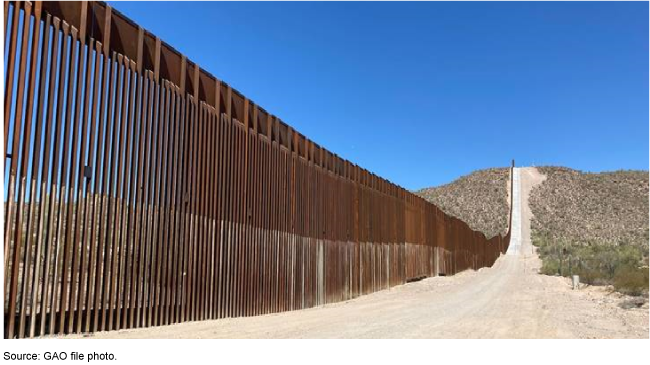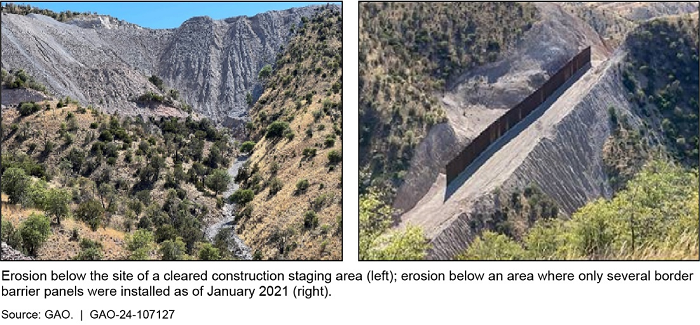Southwest Border: Cultural and Natural Resource Impacts from Barrier Construction
Fast Facts
In this statement for the record, we wrote that from 2017 through Jan. 2021, federal agencies built about 450 miles of barriers along the U.S. Southwest border. To expedite construction, they waived federal environmental and other laws.
The construction harmed some cultural and natural resources, e.g., by blasting at a tribal burial site and altering water flows.
Before building, the agencies assessed some potential effects of the construction. But federal officials and stakeholders said they didn't get enough information from the Department of Homeland Security to give meaningful input.
Our prior recommendations address these and other issues.

Highlights
What GAO Found
In September 2023, GAO found that the Department of Homeland Security’s (DHS) U.S. Customs and Border Protection (CBP) and the Department of Defense (DOD) installed about 458 miles of border barrier panels across the southwest border from January 2017 through January 2021 (GAO-23-105443). Most (81 percent) of the miles of panels replaced existing barriers. The agencies installed over 62 percent of barrier miles on federal lands, including on those managed by the Department of the Interior. Federal officials, as well as representatives of Tribes and stakeholders, noted that the barriers led to various impacts, including to cultural resources, water sources, and endangered species, and from erosion.
Examples of Natural Resource Impacts from Barrier Construction (May 2022)

Before proceeding with barrier construction from 2017 to 2021, CBP waived cultural and natural resource-related laws to expedite construction but took steps to assess the potential impacts of such construction. For example, CBP solicited input from federal agencies and others. Interior officials told GAO that CBP’s information was, in some cases, not sufficiently detailed to facilitate meaningful input. They provided suggestions to GAO for improving CBP’s assessments. CBP has not evaluated lessons learned from its assessments. Doing so could help the agency better identify potential impacts of future projects.
Why GAO Did This Study
To help address illegal cross-border activity, the federal government has constructed hundreds of miles of physical barriers along the southwest border, including on federal lands managed by Interior where important cultural and natural resources are located. DHS and DOD used legal authorities to waive various cultural and natural resource-related laws to construct border barriers from January 2017 through January 2021. A presidential proclamation paused construction in January 2021.
This statement describes border barrier installed from 2017 through January 2021 and associated impacts, and CBP and DOD assessments of potential impacts from construction conducted during that time. This statement is based on GAO’s September 2023 report entitled Southwest Border: Additional Actions Needed to Address Cultural and Natural Resource Impacts from Barrier Construction. GAO reviewed laws, regulations, and guidance applicable to the construction of border barriers. To describe border barrier installed, GAO analyzed CBP’s geospatial data. To identify impacts from the construction and to evaluate CBP’s and DOD’s pre-construction assessments, GAO reviewed agency documents, including assessment. GAO also interviewed officials from federal agencies and a nongeneralizable sample of two tribal governments and five nongovernmental stakeholders.
Recommendations
In its September 2023 report, GAO recommended that CBP, with input from Interior, DOD, Tribes, and stakeholders, evaluate lessons learned from its prior assessments of potential impacts. CBP agreed with this recommendation and stated it would collect information and compile a lessons learned report by June 2024.
